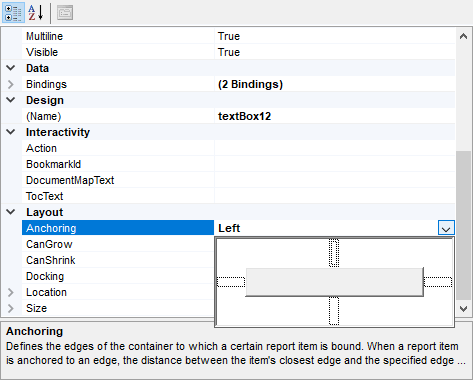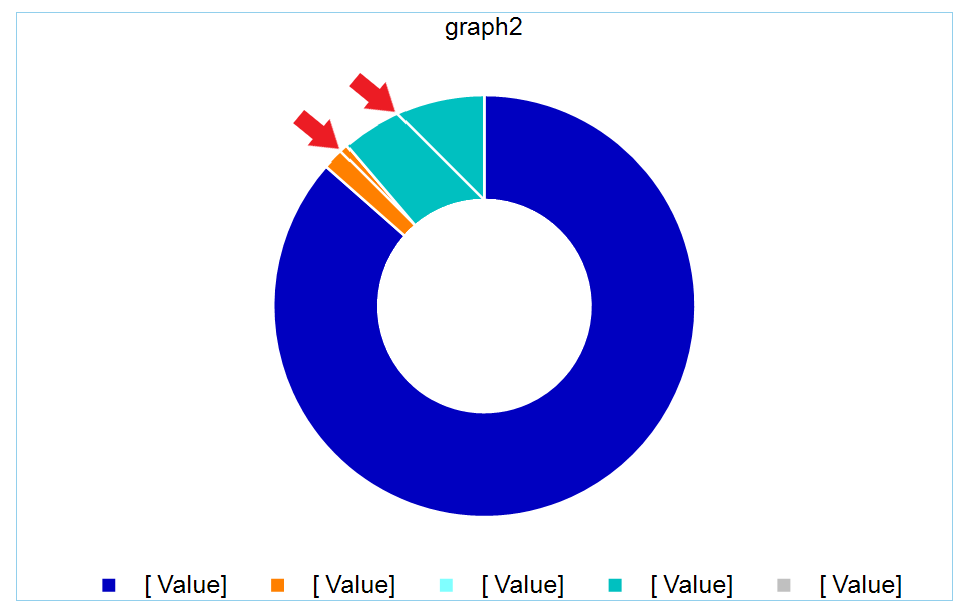We separated our data objects into a library project and then referenced it via the web.config. It works as intended, both in the designer and during data retrieval, but to update the dll with more objects we have to restart the whole site.
It would be very useful if we could substitute our assemblies without restarting the website.
When a report has a report parameter using a data source, that is visible and has AllowNull set to True, if the value initial value is invalid, no report parameter widget is loaded at all for this parameter.
If this is the only report parameter, the parameters area is not rendered at all, even though the toolbar indicates that it is active.
The issue can be reproduced by loading the attached report in the native Blazor Report Viewer.
I wanted to add some white space between the TOC text and the leader symbols in my TOC. Here is the default TOC when I don't use whitespace:
I tried the following Expression:
= Fields.group1 + " "
Here is the result - the TOC text of the first level was displaced as if the added whitespace is before the text:
The workaround I found is to add one LeaderSymbol at the end of the whitespace string:
= Fields.group1 + " ."
Still, it seems that there is whitespace trimming that is not correctly implemented for the TOC section.
In some scenarios, the PrintOnLastPage functionality of the page sections does not work as expected.
For example, if the report with PrintOnLastPage is the last one in the report book, on the last page of the report book, which will also be the last page for that report, a page section will still be rendered even if PrintOnLastPage is False.
This happens when the default PageNumberingStyle.Continue is used by the reports.
On the other hand, if the last report has a PageNumberingStyle.ResetNumberingAndCount, the page section will not be rendered if PrintOnLastPage is set to False, so in this scenario, it works as expected.
In such a case, the following exception is thrown
Inner exception: System.ArgumentException: The path is not of a legal form. at System.IO.Path.NormalizePath(String path, Boolean fullCheck, Int32 maxPathLength, Boolean expandShortPaths) at System.IO.Path.InternalGetDirectoryName(String path) at Telerik.Reporting.Interfaces.FrameworkDependentDeploymentModel.GetDirectory(Assembly assembly) in
The likely reason for the error is that since the assembly is loaded from the bytes, and not from a path, the assembly.Location in the Telerik.Reporting.Interfaces.FrameworkDependentDeploymentModel.GetDirectory method is Null.
Attempting to delete a group section from the Explorer tab in the Web Report Designer leads to the following error being thrown in the browser console:
Uncaught (in promise) Error: Rollback inner transaction
RollbackTransaction http://localhost:51863/api/reportdesigner/designerresources/js/webReportDesigner-16.2.22.1109.min.js/:9
Rollback http://localhost:51863/api/reportdesigner/designerresources/js/webReportDesigner-16.2.22.1109.min.js/:9
execute http://localhost:51863/api/reportdesigner/designerresources/js/webReportDesigner-16.2.22.1109.min.js/:9As a result, the section is not deleted. However, the section can be deleted by deleting the corresponding report group from the Properties area(Data section) in the Web Report Designer.
The source of my SubReport was in a nested class and in the preview of the main report I received the error "Invalid report type" although the same nested class was successfully discovered in the VS designer with the assembly-qualified name 'Test.Class1+DetailReport1, Test, Version=1.0.0.0, Culture=neutral, PublicKeyToken=null'.
When I tried using a class (without a nested class, e.g., 'Test.DetailReport1, Test, Version=1.0.0.0, Culture=neutral, PublicKeyToken=null') then I could get the subreport to render within the main report.
It could be the syntax for the qualified name is not handling nested classes.
Using a Toggle Visibility action to expand/collapse recursive SubReport results in the "Node should be found among parent nodes" error. The recursive SubReport renders fine without the action.
The report from the How to represent hierarchical flat data in report recursively - Telerik Reporting KB article was used as a base.
Recursive sub-report with hierarchical data. When expanding/collapsing, all nodes get expanded or collapsed.
I would expect only the selected node to be expanded/collapsed.
For reference, the report from the How to represent hierarchical nested data in report recursively - Telerik Reporting KB article was used as a base
For example:
Item("MyProperty",Fields.MyDictionary)This would add a invaluable degree of freedom when considering the structure and usage of report's datasources. For example, the current way of working with ExpandoObject (which are also IDictionaries) is very problematic and in my opinion not a good way of doing it. One such utility function will eliminate almost all of the problems that are present at the moment.
Another way (even better) would be to make something like:
Fields("MyProperty")If both ways are added, this will completely (in my opinion) eliminate all the problems using dictionaries and expando objects in reporting.
The JS file with the stringResources shipped with the installation at the following location:
C:\Program Files (x86)\Progress\Telerik Reporting <Release>\Html5\ReportViewer\js
is incorrect, it should be as shown in the Localization - Telerik Reporting article.
Basically, line 9 should be changed to:
; (function (trv, $) {while lines 178 to 180 should be like this:
trv.sr = $.extend(trv.sr, sr);
}(window.telerikReportViewer = window.telerikReportViewer || {}, jQuery));When developing a Telerik report template with the intention of exporting to Excel, I observed the % sign was not displaying for positive numbers in the exported Excel file. The format we were using was {0:N2}%. The results displayed on the HTML report viewer and the Word export document was correct:
However in the excel file result, the cells were formatted without the % for positive numbers, and with the % for negative numbers.
Upon further inspection, I noticed the excel cell formatting was translated as:
This format would not generate the % symbol for a positive number as the trailing % is missing before the semi-colon.
We are fixing this by using the below Format specification directly in the Report Designer:
{0:#,##0.00"%";-#,##0.00"%"}
which is directly retained in the excel custom format:
While I understand that N, C etc. C# number formats are supported according to the design considerations and this bug is also technically resolved by using UseExtendedFormatting (setting this to false translates {0:N2} to #,##0.00"%"), this seems like an unexpected result of translating the format codes that does not match the standard behavior of {0:N2}%. Reporting this behavior for review.
If you set the anchor property and validate it, if I come back on the property, the designer does not show the current anchor.
As you can see, anchoring is defined to left, but it is not shown in the dropdown of the property. The anchoring left should be grey.
The attached 'Test.svg' image markup file contains 'use' statements that lead to duplicating part of the image parts when rendering the report in PDF.
The other file in the archive, 'Test-noUsings.svg' is the same image without 'use' statements and doesn't have this problem.
When the "Kind" localization property of the Web Report Designer is changed, the ExternalStyleSheets editor breaks, and it cannot be used.
Hardcoded values are used when checking against "LocalizedName" in a few other places as well. Some of which are:
- "Kind" === e.LocalizedName
- "Path" === e.LocalizedName
- "Path" !== e.LocalizedName
- "Width" === this.LocalizedName
- "Height" === this.LocalizedName
According to the Excel Rendering Design Considerations article:
- The "f" DateTime format string should result in a full date/time pattern with a short time pattern.
- The "F" DateTime format string should result in a full date/time pattern with a long time pattern.
After exporting to XLS/XLSX, the time formats are as follows:
- "f" -> full date/time pattern with a long time pattern.
- "F" -> full date/time pattern with a short time pattern.
The chart BarSeries has DataPointStyle > LineColor set to white so that there is a white small gap between them. However, this has led to incorrect behavior if the chart contains small values, in relation to other values. The chart shows lines that should not be there:
This regularly raises flags during security audits.
Essentially users can create data in the system that will appear in a cell of the report, and execute as a macro and allow running custom code on the computers of anyone who opens the xls or xlsx file.
Currently there is a setting to protect Telerik's exports CSV exports ("FormulaPrefix")
https://docs.telerik.com/reporting/doc-output/configure-the-export-formats/csv-device-information-settings
The same setting should be introduced for Excel (xls & xlsx) exports.
It should be another parameter of the xls/xlsx export extensions









